

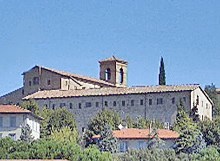
A community of Poor Clares that was established here in 1329 moved to San Paolo del Favarone in 1429. A group of female Franciscan tertiaries from Santa Maria di Valfabbrica moved here at this point.
The community at Santa Maria di Valfabbrica had been formed in 1383, when Madaluccia di Nucolo had been granted the use of a ruined chapel near San Francesco al Prato. When Madaluccia had died in 1408, she had left all of her goods to this (by then well-established) community. From 1429, this community and the off-shoot at Sant’ Agnese formed a single congregation. The sisters later concentrated at Sant’ Agnese, and the site of Santa Maria di Valfabbrica was used for the cemetery of the Convento di San Francesco al Prato.
The nuns looked for spiritual guidance to the Observant Franciscans from the Convento di Monteripido.
In 1482, Pope Sixtus IV granted the friars’ request that they should be allowed to withdraw their spiritual guidance from the sisters of both Sant' Agnese and Sant' Antonio da Padova, because the sisters’ refusal to accept clausura. The sisters reacted by holding two identical open chapter meetings, and sent notarised minutes of their public arguments on the matter to Sixtus IV. He rapidly moved to diffuse the issue by placing the sisters under the spiritual guidance to the newly-arrived Amadeiti Fathers at San Girolamo.
In 1566, Pope Pius V issued the bull Circa Pastoralis, which decreed that tertiary nuns other non-cloistered female communities should take solemn vows and adopt clausura. Pressure on the sisters to accept clausura probably intensified from 1568, when Pius V merged the Amadeiti Fathers with the main branch of the Franciscans. The nuns of Sant' Agnese seem to have accepted enclosure in ca. 1570.
The nunnery of Sant' Antonio da Padova took refuge here when their nunnery was suppressed in 1798-1800. Sant’ Agnese itself was closed during the French occupation in 1810: the nuns took refuge with those of Santa Maria di Monteluce, returning to Sant' Agnese in 1816. They managed to escape suppression in 1860, although they suffered the confiscation of some of their possessions. They reverted to the rule of the Poor Clares in 1911, and in 1927 much of their confiscated property was returned. In 1944 they temporarily abandoned the clausura of their nunnery so that the local people could use its well when bombing disrupted the usual water supply.
A notice on the door gives the times at which you can ring in order to see the fresco by Perugino (below). The sisters will also allow you to see the church at these times.
Cappella della Consolazione

Madonna delle Grazie (1522)
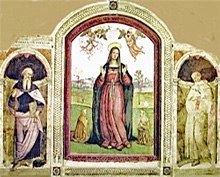
This fresco is on a wall in what is now the Cappella della Consolazione. The nuns have always venerated it because they believe that it protects their community. It is in the form of a frescoed triptych, with the orant Virgin with two kneeling nuns in a landscape, flanked by SS Antony Abbot and Antony of Padua. Its recent restoration has confirmed its attribution to the aged Perugino.
This restoration recovered the original inscription, which gave both the date and the names of the donors: Eufrasia degli Arcipreti and Teodora di Pier Matteo (presumably the nuns who kneel on either side of the Virgin). It also established that the fresco remains on the wall on which it was originally painted (contradicting earlier theories that it had been detached from its original location and moved here). The wall in question seems to have been open to the elements in the nuns' cloister until the construction of the chapel.
Church (1602)
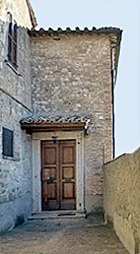
Crucifixion with Saints (1519)
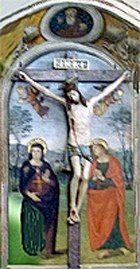
-
✴The main scene depicts the Virgin and St John the Evangelist, with angels above collecting the blood of Christ.
-
✴The plague saints SS Sebastian and Roch are depicted on the sides of the niche, with God the Father above.
Art from the Church
Marzolini Triptych (ca. 1275)
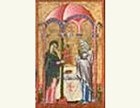
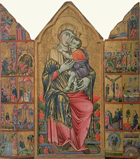
The triptych, which is the autograph work of the Maestro del Trittico Marzolini (or Maestro del Trittico di Perugia), came from the Templars’ church of San Bevignate. It depicts:
-
✴the Madonna and Child in the central panel;
-
✴scenes from the life of Christ on the left; and
-
✴scenes from the Passion on the right.
The fact that the Templars commissioned the work is evidenced by an altar cloth in the scene of the Presentation at the Temple, which is decorated with their distinctive red cross.
The Templars were accused of heresy in 1307, and the Franciscans of San Francesco al Prato were appointed to act as Inquisitors at San Bevignate. Their goods were confiscated at this point and the triptych later found its way to this Franciscan nunnery. The nuns probably commissioned the later paintings of SS Francis and Clare on the outer sides of the covers.
In 1907, when the triptych was exhibited in Perugia, it was recorded as the property of Monsignor N. Marzolini. It passed to the Galleria Nazionale shortly thereafter.
Sant’ Agnese Triptych (1430s)
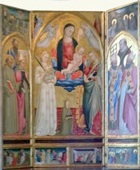
-
✴In the central panel, which depicts the mystic marriage of St Catherine, the Madonna and Child float on a cloud:
-
•St Catherine of Alexandria (with her wheel) stands to the right, accepting a ring from the baby Jesus;
-
•the titular of the nunnery, St Agnes (holding the Lamb of God) stands to the left; and
-
•St Elizabeth of Hungary (crowned and carrying roses) kneels below.
-
✴The side panels depict:
-
•SS Antony of Padua (with the flames of his eloquence in his hand), Louis of Toulouse and John the Evangelist in the right panel; and
-
•SS Herculanus, Constantius and Laurence (with his grill) in the left panel.
-
✴The panels in the upper register depict:
-
•the stigmatisation of St Francis, on the left;
-
•the Annunciation, in the spandrels of the centre panel; and
-
•SS Jerome, Onuphrius (Onofrio, Humphrey) and Paul the Hermit (who kneels in front of his cave), on the right.
-
✴The predella panels depict:
-
•the risen Christ appearing to St Mary Magdalene and insisting “nole me tangere” (do not touch me);
-
•St Catherine rejecting the marriage proposal of the king;
-
•St Elizabeth caring for the infirm; and
-
•the baptism of Christ.
-
✴The outer surfaces of the side panels (illustrated in the site of Musei d’ Italia) depict:
-
•the obscure Blessed Pavino del Bastone on the left; and
-
•St Ives (Sant’ Ivo di Bretagne) on the right. [St Ives, who died in 1303, was a Franciscan tertiary from Kermartin, Brittany. He trained as a lawyer and frequently defended people who were too poor to pay for legal advice. He was canonised 1347.]
Sant' Agnese Altarpiece (1517)
This altarpiece, which is dated by inscription, is attributed to Berto di Giovanni. It was first recorded in 1801, when the nuns gave its main panel to those of Santa Maria di Monteluce in return for the hospitality given to them after their suppression in 1798.
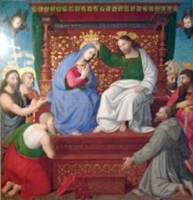
This main panel, which depicts the Coronation of the Virgin with SS Peter, John the Baptist and Jerome on the left and SS Francis, Paul and Herculanus on the right, is based on a drawing by Raphael that is now in the Ashmolean Museum, Oxford. After its transfer to Santa Maria di Monteluce, it was installed on the high altar, where it replaced the panel on the same subject that had been confiscated in 1797. It was listed among works to be sent to the Musei Capitolini, Rome in 1812, but it was subsequently decided that it should remain in the church. It was moved to the Galleria Nazionale in 1863.
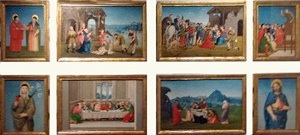
The smaller panels from the altarpiece remained in Sant’ Agnese, although some were moved to the Accademia di Belle Arti in 1810. Eight of them entered the gallery in 1863 and are now displayed together, but separately from the main panel. Their original disposition is unknown, and there might have been others that have been lost:
-
✴Four in the format of vertical rectangles, which probably came from the pilasters of the frame, depict:
-
•SS Cosmas and Damian;
-
•St Bernardino of Siena preaching;
-
•St Clare; and
-
•St Louis of France.
-
✴Four in the format of horizontal rectangles, which probably came from the predella, depict:
-
•the Adoration of the Shepherds;
-
•the Adoration of the Magi;
-
•the Last Supper; and
-
•the Pietà.
Read more:
K. Gill, “Scandala: Controversies Concerning Clausura and Women’s Religious Communities in Late Medieval Italy”, in :
S. Waugh and D. Diehl (eds), “Christendom and its Discontents: Exclusion, Persecution, and Rebellion (1000-1500)”, (1996) Cambridge
The controversy regarding clausura at Sant’ Agnese and Sant’ Antonio da Padova is described in pp 179-84
G. Casagrande, “Il Monastero di Sant’ Agnese in Perugia nei Secoli XIV e XV “, Studi Francescani, 76 (1979) 137-169
Return to Nunneries of Perugia.
Return to Monuments of Perugia.
Return to Walk V.

